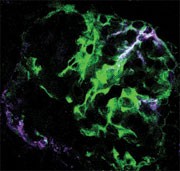
- Select a language for the TTS:
- UK English Female
- UK English Male
- US English Female
- US English Male
- Australian Female
- Australian Male
- Language selected: (auto detect) - EN
Play all audios:
Previous studies by Romagnani and colleagues, and by other groups, have shown that RPCs in the Bowman capsule can differentiate into podocytes and could potentially replace them after
injury. In the current study, Romagnani and colleagues used primary cultures of human RPCs and various strains of transgenic mice treated with adriamycin (as a model of human focal segmental
glomerulosclerosis [FSGS]) to investigate their hypothesis that proteinuria might contribute to the progression of glomerulosclerosis by suppressing this regeneration.
The researchers found that exposure of human RPCs to transferrin and IgG reduced their viability, whereas exposure to human serum albumin inhibited their differentiation into podocytes by
sequestering retinoic acid and preventing the retinoic-acid-response element (RARE)-mediated transcription of podocyte-specific genes. In transgenic mice with adriamycin-induced nephropathy,
blockade of retinoic acid synthesis increased proteinuria, inhibited RARE activation in RPCs and their differentiation into podocytes, and reduced podocyte number, resulting in worsening of
glomerulosclerosis. In contrast, treatment with retinoic acid reversed albuminuria-induced inhibition of RARE in RPCs, resulting in an increase in their differentiation into podocytes, an
increase in podocyte number, and a decrease in proteinuria.
Anyone you share the following link with will be able to read this content:




